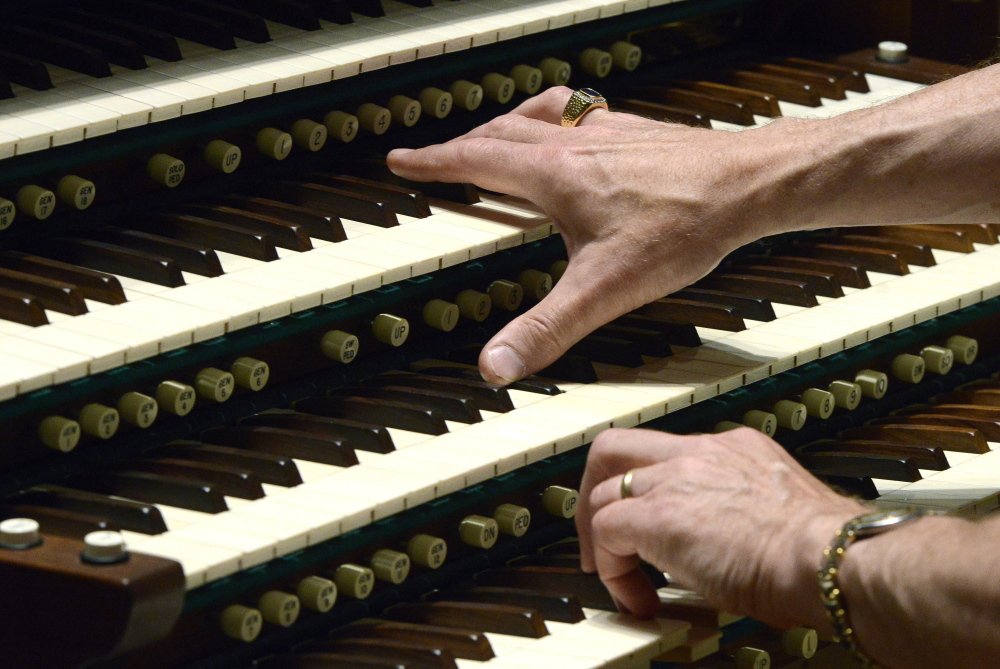Electronic keyboards and I don’t get along. During the recent wedding of a relative, I was asked to play a Chopin waltz for the dance of the groom and his mother. The only instrument available was a keyboard, but hey, how different from the piano could it be? I knew the waltz like the back of my hand.
Wrong!
The millisecond interval between pressing down a key and the occurrence of a sound was so disconcerting that I was barely able to tap out the melody on one hand. It reminded me of previous unsuccessful attempts at playing the organ. There was a disconnect between what I was doing with my fingers and what was coming out of the instrument that left me totally lost.
The organ is a keyboard instrument, but the technique of playing it is totally different from that of the piano, which, comparatively speaking, represents instant gratification,
I thought of these disasters because of the Sept. 27 grand opening concert of the renovated Kotzschmar Memorial Organ at Merrill Auditorium, featuring Peter Richard Conte, Grand Court organist of Macy’s Wanamaker Organ in Philadelphia; Ray Cornils, Portland’s municipal organist; and the Kotzschmar Festival Brass.
The Kotzschmar was the second-largest organ in the world when it was built in 1912, and is one of only two surviving municipal organs in the U.S. – the other being the Spreckels Organ in San Diego, California.
The largest at the time was the Grand Court Organ at Wanamaker’s. It is still the largest operational musical instrument in the world, with six manuals, 463 ranks, 399 registers, 28,677 pipes and a weight of 287 tons. Built by the Los Angeles Art Organ Co. in 1904, it was expanded twice during World War I and the period between World War I and II. In comparison, the renovated Kotzschmar has 102 ranks and 6,862 pipes.
I used to love hearing E. Power Biggs play Bach on the Wanamaker, making the plates in the china department dance on their shelves. I also remember thinking that it reminded me of “The Wizard of Oz.” What did that man on the mezzanine have to do with the rank upon rank of gigantic pipes above him?
In the old days, around 300 B.C., the organ and its player were more intimately connected. The Greek hydraulis, an organ operating on air compressed by the weight of water, was played by opening valves admitting pressurized air to the pipes. It seems to have had a keyboard. A contemporary poet marveled at the volume of sound controlled by the fingertips. Maybe he was taking poetic license. I have read that some organs of the dark ages were played by banging on the valve-opening keys with your fist, rather like ringing a church bell, and with the same purpose of calling the faithful to worship.
Through the centuries, the organ evolved, reaching its apogee as a musical instrument, according to purists, in the 17th and 18th centuries. Before the advent of the telephone exchange, it was the most complex piece of machinery in the world.
In the 19th and early 20th centuries, it became a popular entertainment medium, playing transcriptions of music not generally available to the public in its original form. This led to huge instruments capable of imitating all the voices of an orchestra, although to a trained ear they all sounded primarily like an organ.
The trend toward imitation obscured the organ’s value as a musical instrument in the eyes of serious musicians and composers until Albert Schweitzer, in 1906, wrote a book about Bach and his instruments that rekindled enthusiasm for the organ in its baroque, non electronic form.
Now there are as many flavors of organ as there are of Starbucks coffee. I wouldn’t be surprised if someone released a CD of music played on a hydraulis, if it hasn’t already been done.
Whether one likes the Kotzschmar sound or not, it can do it all, from magnificence to roller rink. That it still exists, now in pristine form, is a tribute to the City of Portland and the supporters of its musical heritage. It will be good to have it back, without any gasps or wheezes.
Christopher Hyde is a writer and musician who lives in Pownal. He can be reached at:
classbeat@netscape.net
Send questions/comments to the editors.



Success. Please wait for the page to reload. If the page does not reload within 5 seconds, please refresh the page.
Enter your email and password to access comments.
Hi, to comment on stories you must . This profile is in addition to your subscription and website login.
Already have a commenting profile? .
Invalid username/password.
Please check your email to confirm and complete your registration.
Only subscribers are eligible to post comments. Please subscribe or login first for digital access. Here’s why.
Use the form below to reset your password. When you've submitted your account email, we will send an email with a reset code.